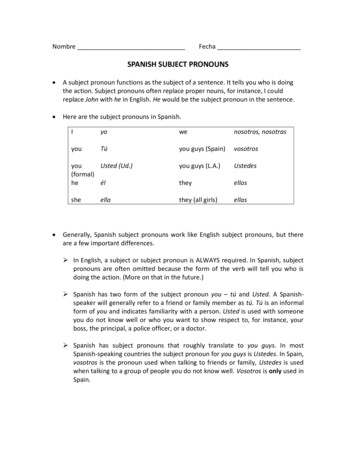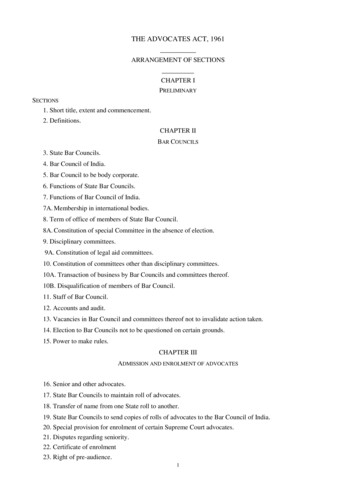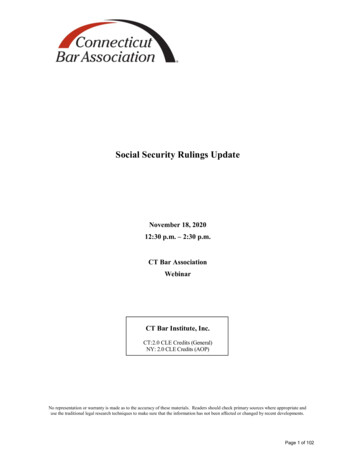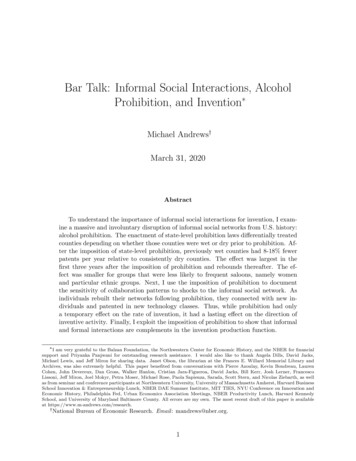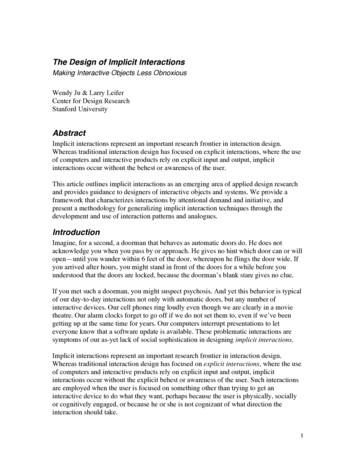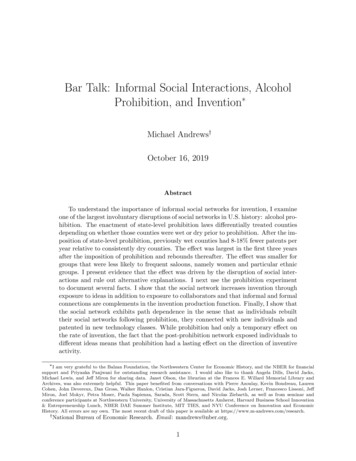
Transcription
Bar Talk: Informal Social Interactions, AlcoholProhibition, and Invention*Michael Andrews October 16, 2019AbstractTo understand the importance of informal social networks for invention, I examineone of the largest involuntary disruptions of social networks in U.S. history: alcohol prohibition. The enactment of state-level prohibition laws differentially treated countiesdepending on whether those counties were wet or dry prior to prohibition. After the imposition of state-level prohibition, previously wet counties had 8-18% fewer patents peryear relative to consistently dry counties. The effect was largest in the first three yearsafter the imposition of prohibition and rebounds thereafter. The effect was smaller forgroups that were less likely to frequent saloons, namely women and particular ethnicgroups. I present evidence that the effect was driven by the disruption of social interactions and rule out alternative explanations. I next use the prohibition experimentto document several facts. I show that the social network increases invention throughexposure to ideas in addition to exposure to collaborators and that informal and formalconnections are complements in the invention production function. Finally, I show thatthe social network exhibits path dependence in the sense that as individuals rebuilttheir social networks following prohibition, they connected with new individuals andpatented in new technology classes. While prohibition had only a temporary effect onthe rate of invention, the fact that the post-prohibition network exposed individuals todifferent ideas means that prohibition had a lasting effect on the direction of inventiveactivity.* I am very grateful to the Balzan Foundation, the Northwestern Center for Economic History, and the NBER for financialsupport and Priyanka Panjwani for outstanding research assistance. I would also like to thank Angela Dills, David Jacks,Michael Lewis, and Jeff Miron for sharing data. Janet Olson, the librarian at the Frances E. Willard Memorial Library andArchives, was also extremely helpful. This paper benefited from conversations with Pierre Azoulay, Kevin Boudreau, LaurenCohen, John Devereux, Dan Gross, Walker Hanlon, Cristian Jara-Figueroa, David Jacks, Josh Lerner, Francesco Lissoni, JeffMiron, Joel Mokyr, Petra Moser, Paola Sapienza, Sarada, Scott Stern, and Nicolas Ziebarth, as well as from seminar andconference participants at Northwestern University, University of Massachusetts Amherst, Harvard Business School Innovation& Entrepreneurship Lunch, NBER DAE Summer Institute, MIT TIES, and NYU Conference on Innovation and EconomicHistory. All errors are my own. The most recent draft of this paper is available at https://www.m-andrews.com/research. National Bureau of Economic Research. Email : mandrews@nber.org.1
1IntroductionWhat is the role of informal social interactions in invention? Scholars in many differentfields recognize that interpersonal communication is important for the creation of new ideas,from urban economics (Glaeser, Kallal, Scheinkman, and Schleifer (1992), Saxenian (1996),Glaeser (1999)) to economic growth (Lucas (2009), Lucas and Moll (2014), Fogli and Veldkamp (2016), Akcigit, Caicedo, Miguelez, Stantcheva, and Sterzi (2018)) to sociology (Burt(2005), Ferrary and Granovetter (2017)). But estimating the causal effects of informal socialinteractions on the rate and direction of inventive activity, let alone understanding the roleof network structure and the response of potential innovators to shocks to the network, haveproven difficult. As Breschi and Lissoni (2009, p. 442) put it, “the role of social ties ascarriers of localized knowledge spillovers has been more often assumed than demonstrated.”In this paper, I answer these questions by investigating one of the largest involuntarydisruptions of social networks in U.S. history: alcohol prohibition. Prior to the enactmentof prohibition laws, the saloon acted as a social hub in which individuals could exchangeinformation in an informal setting (e.g., Moore (1897), Calkins (1919), Sismondo (2011)).1With the passage of prohibition, the state took away these social hubs, disrupting the preexisting informal social network and forcing people to interact in other venues. I observehow invention, proxied by the rate and number of patent grants, changed following the1I describe the history of saloons’ social role in much more detail in Section 2 below. Scholars have notedthe role of bars in bringing creative people together in more recent times (Oldenburg (1989), Florida (2002b)).Examples of inventions conceived in bars are plentiful. A large part of the modern computer industry emergedout of an informal group that met at The Oasis bar and grill (Wozniak (1984), Balin (2001), Farivar (2018)),and numerous innovations were initially sketched on bar cocktail napkins, from the first automatic electronic digital computer and MRI machines to the “Farrington B” credit card font and Discovery Channel’s Shark Week (see book-s-cool-data-center-got-their-starts.html and l-of-fame/).2
prohibition-induced disruption. Prohibition in the U.S. is a particularly useful setting tostudy. Before the passage of federal prohibition, states and counties could determine forthemselves whether or not to allow alcohol consumption in bars. When state level prohibition went into effect, counties that were previously wet saw a disruption of their saloon-basedsocial networks, while the counties that were already dry did not, providing a natural controlgroup.The imposition of prohibition caused patenting to drop by 8-18% in the counties thatwanted to remain wet relative to consistently dry counties in the same state, depending onthe specification used. While patenting fell dramatically in the years immediately after prohibition went into effect, it rebounded over time, consistent with a story in which individualsgradually rebuilt their informal social networks. The drop in patenting was smaller for groupsthat did not typically attend saloons, including women and ethnic groups that were morelikely to drink in private. I present further evidence that the observed effects were drivenby the decline in social interactions rather than by alternative channels such as a decline inalcohol consumption, a general economic slump, or differential migration patterns.I next use the prohibition natural experiment to shed light on several properties of theinvention production function and the network formation process. First, I show that networksare important for innovation because they facilitate the exposure to new ideas, rather thansimply making it easier for individuals to find collaborators. To show this, I document adecline in both solo-inventor patents and patents with multiple inventors. If networks wereonly useful to find collaborators, then solo-inventor patents should see no decline. Second, Idocument that informal and formal connections in a social network are complementary forthe creation of new ideas. Prohibition disrupted only informal connections taking place in the3
saloon, yet patents assigned to firms, which depend at least in part on the formal connectionsbetween coworkers or between employers and employees, also exhibited a decline followingprohibition. Finally, I document that the structure of the network is path dependent. Whenindividuals rebuilt their social networks following prohibition, they did not collaborate withthe same individuals as they did prior to prohibition. This is also manifested in a long-lastingchange in the types of inventions individuals created, as measured by patent classes. Thus,disrupting the informal social network had permanent effects on the direction, if not therate, of innovative activity.In light of these findings, this paper contributes to three literatures. First, the paper contributes to the literature on the economics of innovation and technical change by showingthat informal social interactions are quantitatively important for invention and documentinghow information flows through a social network affect the direction of innovation and theidentities of innovators. Second, the paper contributes to the large empirical literature onsocial networks by showing how a historical natural experiment can be used to test networkproperties in a reduced form way. Third, this study builds on the literature examining thequantitative effects of prohibition (e.g., Dills and Miron (2004) on the effect of prohibition oncirrhosis deaths, Owens (2014) on organized crime, Evans, Helland, Klick, and Patel (2016)on adult height, Bodenhorn (2016) on homicides, Garcı́a-Jimeno (2016) on law enforcement,Hernández (2016) on firm dynamics, and Jacks, Pendakur, and Shigeoka (2016) on infantmortality). Like the studies on infant health, invention is particularly intriguing to studybecause it represents an outcome that was unintentionally affected by prohibition; policymakers and activists had no desire to alter the rate or direction of inventive activity whenpushing for prohibition laws. These results moreover likely understate the effect of prohi4
bition’s disruption of the social network; while invention is a readily observable outcome,social networks are valuable for many other reasons as well (Putnam, 2000).The prior literature has struggled to estimate the causal effect of informal social interactions on invention because of three major challenges, related to identification, size, anddata. Identification poses a challenge because social network structure is endogenous (Manski, 1993). Individuals have a great deal of control over their social interactions, choosingwhere they live, which watering holes to frequent, and who to talk to once they get there.Size poses a challenge because invention is a relatively rare event that often occurs with alag, and so a large and long-lasting intervention is needed to study the effect of social interactions on invention. Finally, data availability is a challenge because microdata on socialinteractions and social network structure is often difficult, costly, or impossible to collect.The prohibition setting allows me to overcome and circumvent each of these challenges.To resolve the identification challenge, I exploit the fact that prohibition was imposedon counties by the state in a way that was orthogonal to the preexisting social network andto other county characteristics that might have been correlated with invention outcomes. Aparticular threat to identification is that counties’ views towards prohibition were a manifestation of deeper social and cultural conservatism that in turn affected openness to newideas (Bénabou, Ticchi, and Vindigni (2016), Vakili and Zhang (2018)). To overcome thisconcern, I leverage the political economy of the prohibition movement and, in the baselinespecifications, restrict attention to counties that had consistent views towards prohibitionover time. More specifically, I use a differences-in-differences framework to compare countiesthat were wet prior to the passage of state prohibition laws and wanted to remain wet tocounties that were consistently dry and wanted to remain dry before and after the passage5
of state prohibition. Counties that had changing views on alcohol are omitted from theanalysis. I consider a number of alternative sample specifications to ensure that underlyingattitudes towards the bar remained constant across time in the treated and control counties,finding consistent results.Prior studies that have overcome the identification challenge typically study relativelysmall shocks to social networks, making it difficult to study innovation as an outcome. Forexample, randomized trials in the development literature (e.g., Conley and Udry (2010),Banerjee, Chandrasekhar, Duflo, and Jackson (2013)) manipulate the introduction of information to a network for small numbers of villages and observe them at only a few points intime. Studies in the education literature that exploit random assignment of peers (Sacerdote(2001), Carrell, Sacerdote, and West (2013)) likewise examine relatively small numbers ofstudents and for limited periods of time.2 Prohibition, in contrast, represents a massive intervention, resolving the size challenge and allowing me to study innovation as an outcome.Bars and saloons were enjoyed by a large swaths of the population prior to prohibition, andprohibition laws stayed in effect for years. Prohibition laws affected large geographic areasas well: my baseline sample consists of 15 states that adopted prohibition laws between 1909and 1919.When existing studies do examine how changes in the social network structure affectinnovative studies, they typically examine groups that are at high risk of innovation, oftenhighly skilled scientists. For instance, Moser and San (2019) examine the inflow of scientists2Carrell, Hoekstra, and Kuka (2018) is an exception in tracking the long-run effects of random exposureto peers, although it still examines a limited sample of students and does not investigate innovation as anoutcome. Other studies that use deaths (Hobbs & Burke, 2017) or natural disasters (Elliott, Haney, andSams-Abiodun (2010), Phan and Airoldi (2015), Morris and Deterding (2016)) to study social network disruption and reconstruction have similar limitations, frequently only tracking network changes for a relativelyshort time after the disruptive shock. They also do not examine innovation as a potential outcome.6
to the U.S. following the passage of immigration quotas in the 1920s; Moser, Voena, andWaldinger (2014) examine the inflow of German Jewish scientists to the U.S. following therise of Nazism in the 1930s; Waldinger (2010) and Waldinger (2012) examine the outflowof German scientists during the same period, Borjas and Doran (2012) and Ganguli (2015)examine the inflow of scientists from the former Soviet Union; and Azoulay, Graff-Zivin,and Wang (2010), Oettl (2012), and Azoulay, Fons-Rosen, and Zivin (2019) examine thedeath of scientists as a natural experiment that disrupts scientists’ social networks. Theprohibition natural experiment differs from these studies in that I can study innovation inthe entire population, including observing individuals’ entry into innovative activities.3 Inaddition, prohibition is a “cleaner” setting in which to study the effects of social interactionson innovation, since prohibition disrupted the structure of the local social network but didnot alter the scale of the network or the identities of the individuals within the network.While I do not have detailed microdata on the informal social network–that is, I cannotobserve exactly which individuals were going to bars before prohibition, who they weretalking to, or what they were talking about–I do know a great deal about the types ofindividuals affected by prohibition, and I am able to use this information to infer a greatdeal about the role of informal social networks for invention. As noted above, I show thatpatenting dropped the most following prohibition for the groups that were most exposed tothe saloon prior to prohibition. I build a simple and general model of a social network with adynamic structure similar to Watts (2001) that captures the role of the saloon in facilitatingeasy informal communication between nodes in the network. I then derive a set of reduced3An additional benefit of observing patenting as an outcome is that it is free of congestion. In contrast,space in academic journals, which is used as an outcome in many studies (e.g., Borjas and Doran (2012))may be limited, and so total publications may not change much to shocks to the social network. See Moseret al. (2014) for a discussion of this point.7
form predictions to test for the presence of several properties of the invention productionfunction and the network formation process. In particular, I use data on solo-authoredpatents and collaborative patents to show that the social network benefits individuals byexposing them to new ideas (Hasan & Koning, 2019), in addition to likely providing theopportunity to find collaborators (Boudreau et al. (2017), Catalini (2018)). By observinghow patenting within the firm changes after prohibition relative to patenting outside of firms,I show that formal and informal interactions are complements in the invention productionfunction. Finally, by comparing collaborations in the pre-prohibition network to the postprohibition network, I show that the network exhibits path dependence, meaning that asindividuals rebuild their networks, they are connecting with new people and in new ways, inturn being exposed to different ideas than they were previously.This paper is organized as follows. Section 2 describes the historical context, describingsaloons’ role as places of information exchange and giving an overview of the alcohol prohibition movement. Section 3 presents a simple theoretical model to illustrate the role of thebar in facilitating the exchange of information over a social network. Section 4 describes thedata. Sections 5-8 present the results. Section 5 presents the baseline results and argues thatthey are driven by a disruption of social interactions. Section 6 documents the importanceof the exposure to ideas, rather than simply exposure to collaborators, for invention. Section 7 documents that different sources of ideas are complements in the invention productionfunction. Section 8 shows that the network structure exhibits path dependence and that thismatters for the direction of invention. Section 9 briefly concludes.8
2Historical Background2.1Bars and Social Interactions in U.S. HistoryIn this section, I present historical evidence that bars facilitated exposure to new people andnew information throughout U.S. history. Bars, taverns, pubs, and saloons have long actedas social hubs. The term “symposium” originated in ancient Greece to describe communaldrinking sessions (Lynch, 2011). Pubs and taverns were the primary social gathering place inEngland for both the high and low classes into the late 17th century.4 Around that time, teaand especially coffeehouses began usurping the role of the pub for the upper classes. Thesenew types of drinking establishments played a key role in spreading the ideas of the ScientificEnlightenment. After the expansion of coffeehouses, pubs were no longer the primary meetingplace for intellectuals, but they were still important as the site for commoners to debatepolitical and religious ideas. As Hailwood (2014, p. 74) writes, “[the alehouse] was an arenaof vibrant political expression with greater social depth and geographical breadth than thecoffeehouse would ever achieve.”Across the Atlantic Ocean, tea and coffeehouses never claimed the same role as socialhubs for the sharing of information; instead, that role was filled by taverns and saloons. TheAmerican revolution was plotted in places like Williamsburg’s Raleigh Tavern, Winchester’sBlack Horse Inn, Boston’s Green Dragon Tavern, and Philadelphia’s City Tavern.5 Becauseof their role in fomenting the revolution against England, taverns and saloons became knownas the “nurseries of freedom”; drinking at a public house was seen as a patriotic virtue4In one famous example, London’s George’s Inn was the preferred watering hole for London’s literaryelite over several centuries, being frequented by Chaucer, Shakespeare, and Dickens (Brown, 2014).5See Sismondo (2011) and Cheever (2015) for more information on drinking patterns in colonial America.9
(Rorabaugh, 1979, p. 35). Thus, at a time when the upper classes in England were lookingdown on the pubs as wasteful distractions for the poor and uneducated, in America tavernsand saloons were places frequented by rich and poor, educated and uneducated alike. Theearly American tavern even hosted the high-minded intellectual events that took place incoffeehouses in England; Sismondo (2011, p. 42) notes that the tavern was used “not onlyas a watering hole but also as a classroom and lecture hall”.In the late 19th and early 20th centuries, saloons served the same social functions thattaverns had in earlier eras. Of the ubiquity of the saloon across American culture in thedecades immediately proceeding prohibition, George Ade writes:Not one-half of one per cent of the male population belonged to clubs. Thechurch could not compete with the saloon as a social center because it was aboutas cheerful as a mausoleum while the place on the corner reeked with the kindof unrestrained gayety which has been in partnership with original sin since thebeginning of history.The saloon gave boisterous welcome to every male adult, regardless of his private conduct, his clothes, his manners, his previous record.Thesaloon was the rooster-crow of the spirit of democracy (Ade, 1931, p. 99-100).The social role of saloons was especially valuable for a nation with high geographic mobility.Okrent (2010, p. 28) writes:The typical saloon featured offerings besides drink and companionship, particularly in urban immigrant districts and in the similarly polygot mining and lumbersettlements. In these places, where a customer’s ties to a neighborhood mightbe new and tenuous, saloonkeepers cashed paychecks, extended credit, supplied10
a mailing address or a message drop for men who had not yet found a permanenthome, and in some instances provided sleeping space at five cents a night. Inport cities on the East Coast and the Great Lakes, the saloonkeeper was oftenthe labor contractor for dock work. Many saloons had the only public toilets orwashing facilities in the neighborhood.Saloons also typically housed a community’s first telephone (Duis, 1983, p. 121). Thus,new information often arrived first in the saloon, whether it came via person, mail, orphone. Some saloons even “doubled as lending libraries” (Sismondo, 2011, p. 169). At leastone Midwestern saloon owner referred to his establishment as an “educational institution”(McGirr, 2016, p. 16). When describing the various benefits of the saloon, novelist JackLondon listed its value for spreading ideas first and foremost: “Always when men cametogether to exchange ideas, to laugh and boast and dare, to relax, to forget the dull toil oftiresome nights and days, always they came together over alcohol. The saloon was the placeof congregation. Men gathered to it as primitive men gathered about the fire” (London,1913, p. 33).6Moreover, the post-workday happy hour is not a recent invention: workers typicallymet to drink at their favorite spots after work (Rorabaugh, 1979, p. 132). Many saloonsspecifically catered to skilled workers in particular professions, and workers from differentfirms in the same industry would meet to talk shop, as evidenced by saloon names suchas “Mechanics’ Exchange” and “Stonecutters’ Exchange;” saloons also frequently served as6Jack London’s life vividly illustrates both the bright and dark sides of the saloon in early 20th centuryAmerica. Unable to stem his own consumption, London became an unlikely advocate for women’s suffrage,famously remarking that, “The moment women get the vote in any community, the first thing they do isclose the saloons. In a thousand generations to come men of themselves will not close the saloons. As wellexpect the morphine victims to legislate the sale of morphine out of existence” (London, 1913, p. 204).11
“informal employment bureaus” (Powers, 1998, p. 54). Nor were drinking establishmentsexclusively for the workers. The German lager beer gardens, which became popular inthe second half of the 19th century, were egalitarian locales where employers drank withtheir workers and professionals from various fields interacted (Oldenburg, 1989, p. 96-97).Notably, this time period is what Sokoloff and Khan (1990) and Khan (2005) refer to as “thedemocratization of invention”: patents tended to come not from an aristocratic elite, butfrom skilled workers and craftsmen, the same types of individuals likely to meet in their localsaloon. Indeed, in 1910 the top ten most common inventor occupations included laborers,machinists, carpenters, drivers, manufacturers, and painters.7The importance of these social and informational benefits of the saloon are not simplyan invention of recent social historians, but were well understood by contemporaries; inaddition to London (1913), see Moore (1897) and Calkins (1919).8 Perhaps the best way tosee the value of the saloon as an institution that promoted dialogue and conversation wasto compare it to an emerging institution that discouraged these actions: the cinema (seeSismondo (2011, p. 206-208)). Following a visit to the U.S., G. K. Chesterton remarked:The cinema boasts of being a substitute for the tavern, but I think it is a verybad substitute. I think so quite apart from the question about fermented liquor.Nobody enjoys cinemas more than I, but to enjoy them a man has only to look7I construct counts of inventors by occupation using the matched patent-census data in Sarada, Andrews,and Ziebarth (2019). The most common occupations in other years during this time period are similar.These results are available upon request.8Moore (1897, p. 8) writes of the saloon-goer: “The desire to be with his fellows – the fascination whicha comfortable room where men are has for him is more than he can resist; moreover the things which thesemen are doing are enticing to him; they are thinking, vying with each other in conversation, in story telling,debate. Nothing of general or local interest transpires which they do not “argue” out. The social stimulusis epitomized in the saloon. It is center of learning, books, papers, and lecture hall to them, the clearinghouse for their common intelligence, the place where their philosophy of life is worked out and from whichtheir political and social beliefs take their beginning. As an educational institution its power is very greatand not to be scorned because skilled teachers are not present, for they teach themselves.”12
and not even to listen, and in a tavern he has to talk (Chesterton, 1922, p. 88).2.2Alcohol Prohibition in U.S. HistoryWhile millions of the nation’s men enjoyed the amenities provided by drinking establishments, a growing segment of society was fixated on the dark side of saloons. Okrent (2010,p. 16) stresses that some men spent the majority of their income at the bar, neglected workto drink, or spread venereal disease to their families when they “found something more thanliquor lurking in saloons.” Powers (1998) argues that most types of deplorable behavior inthe saloons were exceedingly rare, including public drunkenness (p. 12), drinking oneselfinto bankruptcy (p. 52), child neglect and spousal abuse (p. 46), and prostitution (p. 31).9But there can be little doubt that these saloon-borne horrors weighed heavily in the publicimagination and either inspired prohibition activists or, at the very least, were used by themas propaganda. Of course, not all prohibitionists were purely altruistic. Closing the saloonwas seen as a way to prevent immigrant groups, primarily Irish and German, from organizingpolitically (Sismondo, 2011, p. 129) and to keep alcohol out of the hands of southern blacks(Pegram (1997), Bleakley and Owens (2010), Okrent (2010, p. 42-46), McGirr (2016, p.72-89)).Against this backdrop, an anti-alcohol movement was brewing. Temperance movementshad existed in the U.S. since at least the start of the Washington Movement in 1840 (Okrent,2010, p. 9-10), and likely several decades before that (Rorabaugh, 1979, p. 191-2), but early9One of the few exceptions in which prostitution appears to have been relatively commonplace was inNew York after the passage of the Raines Act in 1896. The Raines Act stipulated that alcohol could onlybe served on Sunday in places with at least ten beds. Predictably, this led to saloons subdividing their backrooms into numerous “hotel rooms,” turning otherwise legitimate saloons into brothels (Gilfoyle, 1992, p.303-306).13
movements had promoted voluntary abstinence or moderation. A new wave of prohibitionsentiment was uncorked in the late 19th century and continued into the 1920s. Throughoutthis period, anti-alcohol groups, spearheaded first by the Womens Christian TemperanceUnion (WCTU) and then by the Anti-Saloon League (ASL), focused their attention onpassing alcohol prohibition at the local level. The doctrine of the local option meant that eachcounty determined its own liquor laws, unless the state changed the law to supersede the localdecisions. By focusing on influencing local laws, the temperance forces were able to establishbeachheads of dry support throughout the nation. Once prohibition forces had achieved acritical mass of anti-alcohol votes within a state, they pushed for statewide prohibition, eitherthrough legislation or, more commonly, through referendums. As Lewis (2008) argues, stateprohibition campaigns tended to be focused and directed; the groups might intensively targetonly a handful of communities within a state. In addition to eliminating legal alcohol sales inthe affected counties, local prohibition depressed wet voter turnout in subsequent statewidereferendums. Lewis (2008) suggests that this is caused by the elimination of the saloon asa site for political mobilization, but it is also the case that voting against prohibition in astate election held little appeal for voters living in already dry counties. The upshot of thisstrategy is that achieving prohibition at the county level had a disproportionate effect onstatewide vote totals for prohibition. This means that, when statewide prohibition passed,views towards alcohol remained largely constant in most counties that maintained constantlocal option laws.America’s entry into World War I proved to be a valuable opportunity for prohibitionists.W
I would also like to thank Angela Dills, David Jacks, Michael Lewis, and Je Miron for sharing data. Janet Olson, the librarian at the Frances E. Willard Memorial Library and Archives, was also extremely helpful. This paper bene ted from conversations with Pierre Azoulay, Kevin Boudreau, Lauren
